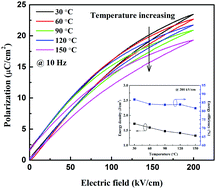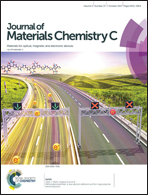Relaxor ferroelectric 0.9BaTiO3–0.1Bi(Zn0.5Zr0.5)O3 ceramic capacitors with high energy density and temperature stable energy storage properties
Abstract
A relaxor ferroelectric ceramic for high energy storage applications based on 0.9BaTiO3–0.1Bi(Zn0.5Zr0.5)O3 (0.9BT–0.1BZZ) was successfully fabricated via a conventional solid-state method. The sintered samples have a perovskite structure with a pseudocubic phase, showing a moderate dielectric constant (500–2000), low dielectric loss (tan δ < 0.15) and highly diffusive and dispersive relaxor-like behavior. The weak dielectric nonlinearity exhibits a dielectric constant change of ∼10% as the bias electric field increases from 0 kV cm−1 to 40 kV cm−1. Extra slim polarization–electric field loops accompanying the slow decrease of breakdown strength from 266.5 kV cm−1 to 217.7 kV cm−1 are observed in a measured temperature range of 30–150 °C. A maximum energy density of 2.46 J cm−3 was obtained at the electric field of 264 kV cm−1 close to the breakdown strength at ambient temperature. Temperature stability of both energy density and energy efficiency exists in a wide temperature range, which makes BT–BZZ ceramics promising candidates for high power electric applications.



 Please wait while we load your content...
Please wait while we load your content...